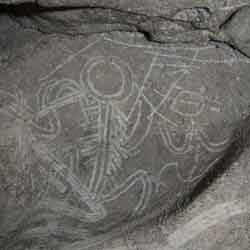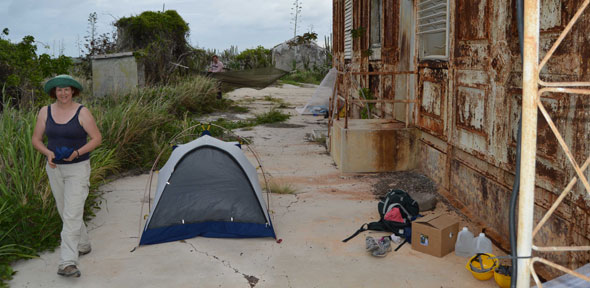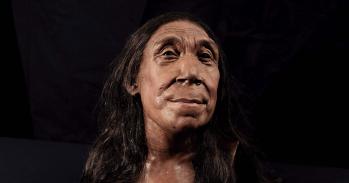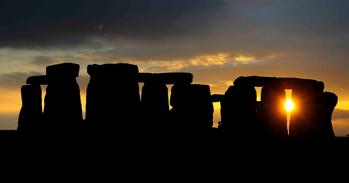
Lucy Wrapson reports on her fieldwork analysing the curious cave paintings found on Isla de Mona, in the Caribbean, and their equally enigmatic artists.
Lucy Wrapson reports on her fieldwork analysing the curious cave paintings found on Isla de Mona, in the Caribbean, and their equally enigmatic artists.
Finger-drawn designs and extensive extractive finger scratches are sometimes deep within the ‘dark zones’, where no natural light falls
Lucy Wrapson
Isla de Mona has been many things: a source of melons and cotton hammocks for conquistadors in the 16th century; a pirate haunt in the 17th and 18th centuries; an industrial island fertilising the fields of the Western world with the fossilised guano of giant fish-eating bats in the 19th; a US air base in the 20th; and now, both a nature reserve and a destination for migrants seeking a better life in the USA.
This tiny island, just seven miles by four, with no permanent settlement, lies in the dangerous Mona Passage between Puerto Rico and the Dominican Republic, and it is the prehistory that brings us here.
The plateau of limestone and dolomite is riddled with caves filled with signs of human activity. Much of this is pre-Columbian (i.e. before the Spanish arrived in the late 15th century) and consists of painted images, finger-drawn designs and extensive extractive finger scratches, which are sometimes deep within the ‘dark zones’, where no natural light falls.

I am with archaeologists Dr Alice Samson from Cambridge’s McDonald Institute for Archaeological Research and Dr Jago Cooper from the British Museum for their summer fieldwork. As a conservator with specialism in the materials and techniques of painting, I am here to analyse the pigments used to make pre-Columbian markings and with the team look at the layer structures of engravings and painted images.
I’m using an X-ray fluorescence spectrometer to examine the elemental composition of the pictographs, and will later take tiny samples away for further analysis. I want to find out whether the people who made these images used materials that were at hand in the caves, or transported them in from elsewhere.
Mona’s prehistoric peoples appear to have lived on the island from at least 2800 BCE, surviving a century after the arrival of the Spanish at the end of the 15th century. The inhabitants at the time of the conquest, commonly referred to as Taínos, brought us the words hurricane, barbeque, hammock, canoe, potato and cannibal.
Caves feature prominently in Taíno mythology and it is likely that many of the anthropogenic images in the caves are zemís (considered by some the origin of the word ‘zombie’). Zemí refers to any object, animal, vegetable or mineral, which was animate and could be called upon to intervene in human affairs. Zemís were found, constructed or painted in 3D and 2D form. Although the presence of human-like figurative designs is common in Caribbean rock-art, Alice and Jago’s work is bringing to light a staggering amount of physical modification to the caves from the pre-Columbian era, particularly the extraction of soft white lime from the walls and ceilings. The purpose of this extraction and what the material was used for are not yet known.
Each morning I wake at 5.30am to the sounds of subtropical birds. It’s the only time of day cool enough to go for a run. The coastguards and rangers all eat early; for them, life on Mona is a cycle of week-on-week-off at work, with a small aircraft bringing them to and from the Puerto Rican mainland to Mona via a bumpy grass airstrip.

At the camp, there’s a small study centre (happily, with solar-powered Wi-Fi) as well as basic accommodation where the workers live, and where migrants can rest before they are moved from the island. Mona throws together strange combinations of people: border police, rangers, military personnel, scientists, cavers, immigrants and boy scouts.
We set off early in the morning. Some of the caves are nearby, but others involve more effort to carry our equipment, as they are some distance from our camp. Mona’s environment can be inhospitable and it has a fearsome reputation. There is little natural water, except sometimes deep in the caves. It is dry, hot and thorny, and the rocks are sharp. As we walk to the caves, we often disturb one of Mona’s endemic and therefore incredibly rare iguanas. They typically scuttle away from us into a hidden cave mouth.
Our team also includes Masters’ students from the Centro de Estudios Avanzados in Puerto Rico, and we work together analysing, documenting and photographing the evidence in the caves. Colonists, buccaneers, guano-miners and boy scouts have all left their mark, often with dated graffiti. On several days, we join a team of cavers who year on year visit this most cavernous location on earth to map the island’s 200-plus caves. It’s a great opportunity to learn about cave mapping and geology from experts.
If possible, lunch is taken in a cliff-side cave mouth, with a view out over the sea. On occasion, two nosy Red-Footed boobies wheel round and round to get a better look at us. The caves themselves are extremely hot, humid and dirty. At the end of the day we walk into the Caribbean sea, fully dressed in our ‘cave clothes’.
Images: Finger drawings and Lucy Wrapson
Credit: Alice Samson/El Corazon del Caribe Research project

The text in this work is licensed under a Creative Commons Attribution 4.0 International License. For image use please see separate credits above.


